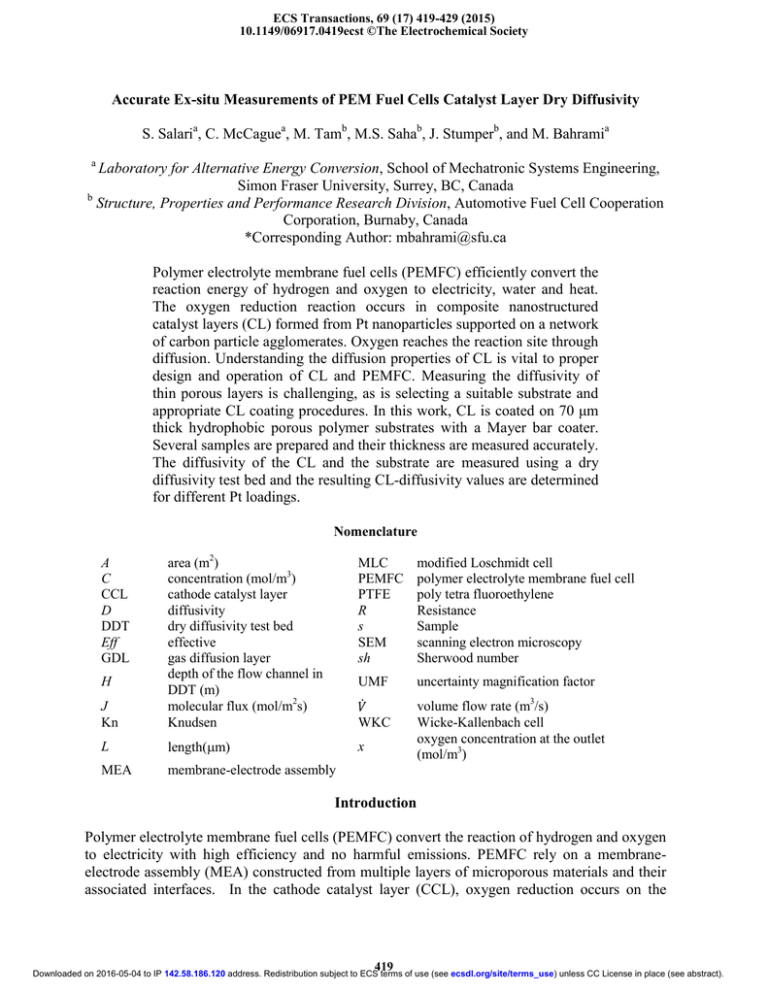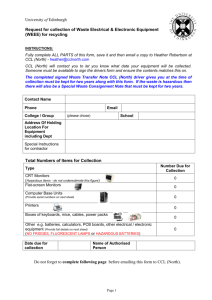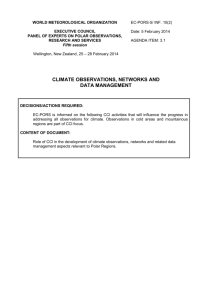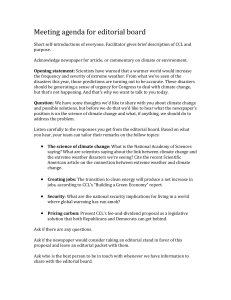Accurate Ex-situ Measurements of PEM Fuel Cells Catalyst Layer Dry... S. Salari , C. McCague
advertisement

ECS Transactions, 69 (17) 419-429 (2015) 10.1149/06917.0419ecst ©The Electrochemical Society Accurate Ex-situ Measurements of PEM Fuel Cells Catalyst Layer Dry Diffusivity S. Salaria, C. McCaguea, M. Tamb, M.S. Sahab, J. Stumperb, and M. Bahramia a Laboratory for Alternative Energy Conversion, School of Mechatronic Systems Engineering, Simon Fraser University, Surrey, BC, Canada b Structure, Properties and Performance Research Division, Automotive Fuel Cell Cooperation Corporation, Burnaby, Canada *Corresponding Author: mbahrami@sfu.ca Polymer electrolyte membrane fuel cells (PEMFC) efficiently convert the reaction energy of hydrogen and oxygen to electricity, water and heat. The oxygen reduction reaction occurs in composite nanostructured catalyst layers (CL) formed from Pt nanoparticles supported on a network of carbon particle agglomerates. Oxygen reaches the reaction site through diffusion. Understanding the diffusion properties of CL is vital to proper design and operation of CL and PEMFC. Measuring the diffusivity of thin porous layers is challenging, as is selecting a suitable substrate and appropriate CL coating procedures. In this work, CL is coated on 70 μm thick hydrophobic porous polymer substrates with a Mayer bar coater. Several samples are prepared and their thickness are measured accurately. The diffusivity of the CL and the substrate are measured using a dry diffusivity test bed and the resulting CL-diffusivity values are determined for different Pt loadings. Nomenclature MLC PEMFC PTFE R s SEM sh modified Loschmidt cell polymer electrolyte membrane fuel cell poly tetra fluoroethylene Resistance Sample scanning electron microscopy Sherwood number UMF uncertainty magnification factor J Kn area (m2) concentration (mol/m3) cathode catalyst layer diffusivity dry diffusivity test bed effective gas diffusion layer depth of the flow channel in DDT (m) molecular flux (mol/m2s) Knudsen L length(m) �̇ WKC x volume flow rate (m3/s) Wicke-Kallenbach cell oxygen concentration at the outlet (mol/m3) MEA membrane-electrode assembly A C CCL D DDT Eff GDL H Introduction Polymer electrolyte membrane fuel cells (PEMFC) convert the reaction of hydrogen and oxygen to electricity with high efficiency and no harmful emissions. PEMFC rely on a membraneelectrode assembly (MEA) constructed from multiple layers of microporous materials and their associated interfaces. In the cathode catalyst layer (CCL), oxygen reduction occurs on the 419 Downloaded on 2016-05-04 to IP 142.58.186.120 address. Redistribution subject to ECS terms of use (see ecsdl.org/site/terms_use) unless CC License in place (see abstract). ECS Transactions, 69 (17) 419-429 (2015) platinum particles. Pt particles are embedded in agglomerates of carbon support particles. Oxygen reaches these reaction sites through diffusion and the product of reaction, water vapor, leaves the CCL through diffusion. Therefore, CCL gas diffusivity affects the uniformity of reaction within the CCL, the lifetime of the CCL, and the power density of the fuel cell (1). Diffusivity Measurement Methods. As oxygen diffusivity within the CCL directly affects fuel cell output, many studies deduce CCL diffusivity indirectly by investigating polarization curves of PEMFC. In such methods, impedance spectra of the cell are measured for the same cell current but different oxygen concentrations in the cathode channels. Based on the difference between resistivity of the cell for different concentrations, oxygen diffusivity can be calculated (2-3). The accuracy of such diffusivity measurements is highly influenced by the model relating the impedance of CCL to its diffusivity (4). There are a limited number of direct measurements of the in-plane diffusivity of CCL (5-6). Rashapov et al. (5) measured in-plane diffusivity of CCL with a transient approach. They showed the decrease in diffusivity of CCL under compression was not only due to change in porosity, but also due to change of tortuosity. Yu and Carter (6) measured in-plane diffusivity of CCL with a steady state approach for different ionomer to carbon ratio (I/C) ratios and relative humidity (RH) values. They showed that increasing I/C ratio decreased diffusivity significantly, while increasing RH decreased diffusivity slightly. The gas diffusion in CCL occurs mostly through-plane, but there are limited available data, measured directly, to prove this hypothesis mostly due to challenges involved in direct measurements of diffusivity in CCL. The diffusion resistance of CCL is small for through-plane direction as the CCL is generally less than ~10 µm thick. Measuring diffusivity of thin layers demands a precise measurement system capable of detecting minor changes in gas concentration. Shen et al.(1) measured through-plane diffusivity of CCL samples that were spray coated on alumina substrates using a modified Loschmidt cell (MLC) apparatus. The MLC has two chambers filled with different concentrations of oxygen and separated by the sample and a valve. When the valve opens, oxygen diffuses through the sample into the adjacent chamber. The oxygen concentration is monitored at a specific location in the second chamber. Based on analytical solution for the 1D gas diffusion presented in Eq. 1 (1) and the equivalent resistance of the chambers (for unit of area) with the sample Eq. 2, diffusivity of the sample is calculated for the obtained oxygen curve. − + z, t = − erf ( [1] ) √ In Eq. 1 C is concentration, C01 and C02 is the initial oxygen concentration of the first and second chamber respectively, z is location, D is diffusivity and t is time. e = ℎ h e e = ℎ h e − ℎ e e + ℎ e e [2] In Eq. 1 R and th are resistance and the sample thickness respectively. The major problem with MLC is its high uncertainty magnification factor (UMF) for oxygen concentration in the case of thin multilayer system (< 200 µm) like CCL (7). UMF 420 Downloaded on 2016-05-04 to IP 142.58.186.120 address. Redistribution subject to ECS terms of use (see ecsdl.org/site/terms_use) unless CC License in place (see abstract). ECS Transactions, 69 (17) 419-429 (2015) values for oxygen concentration is about ~30 in case of ordinary CCLs. Such UMF leads to about ~30% uncertainty values for diffusivity using oxygen probes with 1% uncertainty. Catalyst Layer Deposition. For diffusivity measurements, the CCL has to be coated on a thin porous substrate, and the diffusivity of the CCL must be deconvoluted from diffusivity measured for the multilayer CLL-substrate sample. The substrate should be carefully selected to have a low resistance to gas diffusion compared to that of the CCL. The coating method used to deposit the CCL on the substrate influences the microstructure of CCL and therefore its diffusivity. Many coating methods, such as printing and spraying, demand dilute CCL ink to prevent nozzle clogging. Dilute CCL ink easily penetrates into the porous substrate, especially if it is hydrophilic. Such penetration significantly affects diffusivity resistance by clogging pores of the substrate. Alternatively, CCL can be coated on a solid substrate, and then decal transferred onto the target substrate. However, as the target substrate should be thin and porous, it collapses under the hot pressing conditions of decal transferring. Wicke–Kallenbach cell (WKC) is used in literature widely to measure gas diffusivity in layers of porous materials (8-11). In this study, the diffusivity of CCL is measured using a Wicke–Kallenbach cell (WKC) referred to as dry diffusivity test bed (DDT). The DDT flows two steady gas streams with different oxygen concentrations on opposite sides of a porous sample (12). For small pressure differences below 20 Pa between two flows, the method is capable of measuring diffusivity of samples with pores smaller than 5 µm, such as CCL. The major challenges to measure CCL diffusivity are finding a proper substrate, coating method, and sample preparation procedure, which result in uniform catalyst layer without penetration into the support substrate and high resistance over gas diffusion in compare with the support. In the present work, a hydrophobic thin filter PTFE is chosen for CCL to be coated on with Mayer bar. The substrate is highly porous, thin, and mechanically strong enough to support CCL. The resistance of the filter is in the same range as CCL resistance. The penetration of CCL into the substrate is examined with electron scan microscopy techniques and confirmed to be negligible. The diffusivity of CCL samples with different platinum loadings are measured with DDT. Sample preparation Substrate Selection There are two major criteria to consider when choosing support substrate for the CCL diffusivity tests: i) low diffusion resistance, and ii) low engagement with the CCL. As DDT measures the total resistance of the CCL and the support substrate, the support should have the lowest possible diffusivity resistance relative to the CCL. If the measured diffusivity is dominated by the resistance of the support instead of the CCL, and the uncertainty of deconvoluting the CCL diffusivity from the test results will be high. As the resistance of CCL, which is a thin layer (less than ~10 µm), is small, finding a suitable support with the resistance in the same range is challenging. The support should have sufficient mechanical strength for 421 Downloaded on 2016-05-04 to IP 142.58.186.120 address. Redistribution subject to ECS terms of use (see ecsdl.org/site/terms_use) unless CC License in place (see abstract). ECS Transactions, 69 (17) 419-429 (2015) coating and handling, while being as thin and highly porous as possible to minimize the diffusion resistance. To avoid the CCL penetration into the support, which would create an interfacial region of variable porosity, the pore size of the substrate should be less than 500 nm. Moreover, the surface should be highly hydrophobic to prevent the adsorption of the CCL ink during the coating process. After considerable investigation and trial and error, a PTFE membrane filter (Fluoropore FHUP04700, EMD Millipore) meeting all the above-mentioned criteria, was selected as the substrate for this study. . The 47 mm diameter, 50 µm thick PTFE substrates have a ~80% porosity, a 0.45 µm pore size, and a highly hydrophobic surface. Coating Method A Mayer bar coats catalyst ink onto the support substrate by spreading the ink with a rolling a bar set a specific distance above the surface. Mayer bar can use highly viscous ink, which prevents ink penetration into the surface of a hydrophobic support. Moreover, the coated CCL is uniform compared with spraying or printing based on the authors’ observations. The distance between the rolling bar and the surface of the substrate determines the thickness of the coated CCL. Any wrinkles on the surface of the substrate can highly compromise the uniformity of the CCL. Therefore, special sample preparation methods should focus on minimizing coating imperfections. The circular disc substrates were placed on top of a solid hydrophobic backing layer (e.g. PTFE) with almost the same thickness as the substrate (50 µm). The two materials were punched out using a hole puncher with diameter about 1.75” (slightly smaller than the disc substrate). The substrates were fitted into the holes in the backing layer template and held with a vacuum. While under suction to prevent wrinkling, the edges of the filters were taped to the backside of the template as shown in Figure 1. The template was fixed face up on the coating pad of the Mayer bar to be coated by the rolling bar. After coating and drying, the CCL coated filter substrate discs were carefully peeled off the template, and the cross section of the coated CCL on the filter substrate is examined using SEM imaging to make sure there is no penetration into the substrate (Fig. 2). The cross section is obtained by freeze and fracture, which in the coated filter fixed in the sample holder, was dipped into the liquid nitrogen for several minutes, and cut with a lancet. Freeze and fracture minimize cutting effects on the cross section. Clearly distinguishable regions for the filter and the CCL were observed. CCL was detached from filter in some regions, which showed that there was no visible penetration. CCL Specification A highly viscous ink (low water and propanol content) with I/C about 1.1 was used to prepare the samples. CCL ink was coated on the substrates with different rolling bars to make samples with Pt loadings ranging from 144 to 280 g/cm2. A total of thirty samples were prepared, however, some of the samples were not perfectly coated or were torn detaching them 422 Downloaded on 2016-05-04 to IP 142.58.186.120 address. Redistribution subject to ECS terms of use (see ecsdl.org/site/terms_use) unless CC License in place (see abstract). ECS Transactions, 69 (17) 419-429 (2015) from templates. Three methods were used to measure CCL thickness. Thickness of the substrate and the substrate coated with CCL were measured with a precise caliper (~1 µm accuracy) and a custom-made Tuc Ruc machine (~1 µm accuracy). The Tuc Ruc is an apparatus designed to measure thickness and resistivity under compression. It has two golden probes that sandwich the sample and exert compression. The Tuc Ruc can measure the sample thickness under compressive loads from 30 kPa to 5000 kPa. As the filter PTFE is highly porous, its thickness changes under compression. As a result, measurements with caliper and Tuc Ruc were not sufficiently accurate. To address this issue, thickness of CCL was measured by studying SEM images of cross-sectioned CCL coated substrates obtained by freeze and fracture procedure. To calculate effective diffusivity of CCL the thicknesses measured with SEM imaging were used. Dry Diffusivity Testbed (DDT) Dry diffusivity testbed (DDT) is an apparatus based on a Wicke–Kallenbach cell (8). There are two flow channels separated by a porous sample, as shown schematically in Fig. 3). Ideally, tests would be conducted with no pressure difference between the two channels to avoid any convective flow through the sample, in reality there is always an uncontrollable minor pressure difference (less than 20 Pa). Pure nitrogen flows in one channel while air flows in the other one. The oxygen concentration gradient between the two sides of the sample drives oxygen diffusion through the sample. Fick’s first law of diffusion, Eq. 3, is the principle of calculating effective diffusivity based on the concentration. The concentration difference will vary with the direction of the initial gas flow. Moreover, there is resistance to the mass transfer of gas into the sample. This resistance is measured and subtracted from the total resistance. The final calculation for effective length is shown in Eq. 4, following (13). Effective length is a representative of resistance and can be related to effective diffusivity through Eq. 5. �=− = � � ( ��̇ ln ( � . � � � − [3] � . ) − 4ℎ ) ℎ [4] Side view Top view Figure 1. Template support for the filter disk substrates to be CCL coated by Mayer bar 423 Downloaded on 2016-05-04 to IP 142.58.186.120 address. Redistribution subject to ECS terms of use (see ecsdl.org/site/terms_use) unless CC License in place (see abstract). ECS Transactions, 69 (17) 419-429 (2015) Filter PTFE 30 µm CCL Figure 2. SEM image of freeze and fracture cross section of CCL coated on filter PTFE. There is no visible penetration for CCL into the filter. a) Pressure gauge Oxygen probe Mass flow controller Sample b) c) Flow inlet Flow channels Oxygen probe Flow outlet Figure 3. a) Schematic of dry diffusivity test bed (DDT), b) DDT, c) schematic of the lower part of DDT sample holder. In Eq. 3 and Eq. 4, J is mass flux, is the effective length of the sample (µm), �̇ is 3 in volume flow rate (m /s), Co is oxygen concentration at the inlet of oxygen rich channel, Coout is the measured oxygen concentration at nitrogen channel outlet, h is channels depth in DDT and Sh is Sherwood number. The effective diffusivity, Deff, of the sample is calculated using Eq. 5 from the measured sample thickness, the calculated binary diffusivity and the measured effective length of the sample. As the CCL does not exist as a stand-alone layer, its diffusivity needs to be deconvoluted from a supporting substrate. The diffusion resistances of the CCL and its supporting substrate are in series as shown in Eq. 6. As a result, the measured effective length of the CCL coated filter is the summation of the effective length of CCL and the substrate (see Eq. 7). 424 Downloaded on 2016-05-04 to IP 142.58.186.120 address. Redistribution subject to ECS terms of use (see ecsdl.org/site/terms_use) unless CC License in place (see abstract). ECS Transactions, 69 (17) 419-429 (2015) � � ℎ� = ��� = + ��� = [5] � � [6] + [7] In this study, the effective lengths for both the bare substrate and the coated substrate are measured. The difference gives the effective length of the CCL. Uncertainty analysis Uncertainty of the calculated non-dimensional effective diffusivity, f, is a function of the uncertainty of the measured CCL thickness and the effective length. To find the relation of the total uncertainty with each parameter uncertainty, the effective diffusivity equation (Eq. 8) should be differentiate with respect to each parameter (14): � ( � � ��� � ��� ) � =√ ��� � − ��� = ��� ��� = [8] − + ��� +( − ��� ��� ) [9] As the filter thickness is sensitive to compression, it is proper to isolate the CCL thickness to minimize the last term in Eq. 9. Therefore, SEM images of cross sections of coated substrates are used to measure CCL thickness directly. One potential issue with this method is that cutting the coated substrate might affect the thickness of the CCL being measured. This problem is minimized using freeze and fracture process. Each measured effective length in Eq. 9 has an uncertainty as well which should be calculated: | |= � √( � −( ̇ �� � (ln ( � � − − � . . . 4 )) ) ) +( � ) +( � ) + �̇ �̇ [10] Through Eqs. 9 and 10, the uncertainty of CCL diffusivity can be calculated based on uncertainty of the measured parameters including the oxygen concentration at the outlet, pressure, temperature and flow rate. The oxygen probe accuracy (~99%) plays a major role in the uncertainty of the diffusivity as its magnification factor for the different Pt loadings is from six to fourteen. 425 Downloaded on 2016-05-04 to IP 142.58.186.120 address. Redistribution subject to ECS terms of use (see ecsdl.org/site/terms_use) unless CC License in place (see abstract). ECS Transactions, 69 (17) 419-429 (2015) Results Effective Diffusivity of CCL Dry diffusivity tests were performed on eight CCL samples with thickesses ranging from 510 m and Pt loadings from 0.14 mg/cm2 to 0.28 mg/cm2. All the samples have the same I/C ratio about 1.1. The Pt loadings and CCL thicknesses of the samples are summarized in TABLE I. Diffusivity tests were performed at room temperature (~20˚C), atmospheric pressure, and relative humidity of 0%. The effective length of the eight bare substrates were measured under identical conditions. The effective length of the substrate was determined to be 112 ± 2 m. This value was subtracted from the effective length of the CCL coated substrates to determine the effective length of the CCL. Fig 4. shows the calculated ratios of diffusivity of CCL to binary diffusivity in open space for the CCL samples as a function of Pt loadings. Considering the random porous structure of CCL, and different crack formation for CCL with different thicknesses, the diffusivity values are highly consistent (~ 0.12) and all values agree within measurement uncertainty. The uncertainty of calculated diffusivities is 15% obtained applying Eq. 9. 0.18 0.16 Deff/Dbinary 0.14 0.12 0.10 0.08 0.06 0.04 0.02 0.00 140 190 240 Pt loading (µgr/cm²) 290 Figure 4. Non-dimensional effective diffusivity for CCLs with Pt loading from 140 to 290 µgr/cm² TABLE I. Sample Pt loadings, CCL thicknesses measured from SEM images of sample cross sections and measured CCL effective length and non-dimensional diffusivity Sample Pt loading (µg/cm2) Thickness (µm) CCL effective length (µm) Deff/Dbinary 1 144 5.4 43.0 0.12 2 144 6.5 49.1 0.13 3 209 8.4 72.2 0.12 426 4 209 9.0 60.1 0.15 5 247 8.6 74 0.12 6 250 9.0 72.5 0.12 7 250 9.5 79.8 0.12 8 280 10.4 74.4 0.14 Downloaded on 2016-05-04 to IP 142.58.186.120 address. Redistribution subject to ECS terms of use (see ecsdl.org/site/terms_use) unless CC License in place (see abstract). ECS Transactions, 69 (17) 419-429 (2015) Comparison Between Different Methods to Obtain Diffusivity TABLE II shows the average value for CCL diffusivity obtained in this study compared with other values reported in the literature. There is limited available data on CCL diffusivity and none of the results in TABLE II are for CCLs prepared by the same procedures or measured under the same conditions. The diffusivity reported in (15) is obtained as a function of porosity by reconstructing the geometry of the CCL using a Monte-Carlo method. Monte-Carlo methods are a broad class of computational algorithms that rely on repeated random sampling to obtain numerical results while preserving some distributed properties. Results in (15) for CCL with porosity of about 0.3 matches the measured diffusivity value in this study. The diffusivity value in reference (16) is numerically calculated using a reconstructing geometry of a CCL by applying nano scale X-ray tomography. The diffusivity value reported in (16) is about 21% greater than values measured in the present study. One factor contributing to this difference could be the different I/C ratios, 0.65 in (16) versus 1.1 in this study. According to (6), an increase in ionomer content of CCL leads to a reduction of diffusivity. The diffusivity reported in (15) is obtained as a function of porosity by reconstructing the geometry of the CCL using a Monte-Carlo method. Monte-Carlo methods are a broad class of computational algorithms that rely on repeated random sampling to obtain numerical results while preserving some distributed properties. Results in (15) for CCL with porosity of about 0.3 matches the measured diffusivity value in this study. TABLE II. Non-dimensional diffusivity values in literature Non-dimensional � Ref Method CCL and test conditions Present work DDT direct measurement I/C=1.1, T=20 ° , RH=0, Pt loading= 0.14-0.29 mg/cm2, Mayer bar, Hydrophobic PTFE filter A. Berson et al. (15) Monte-Carlo geometry reconstruction Porosity=0.3 0.10 S. Litster et al. (16) Nano X-ray tomography, geometry reconstruction I/C=0.65, T=20 ° , RH=50%, Pt loading=0.9 mg/cm2, Hand printed 0.14 J. Shen et al. (1) MLC direct measurement 0.03 Z. Yu and R.N. Carter. (6) WKC direct measurement (in-plane direction) T=25 ° , Spray, Hydrophilic alumina K. Wippermann et al. (2) In situ, Impedance spectra (for DMFC) ~ 10-4 A.A. Kulikovsky. (3) In situ, Impedance spectra (for PEMFC) T=30-90 ° T=80 ° , I/C=0.5, 1 & 1.5, RH=0 T=150 ° 427 0.10 0.01 ~ 10-4 Downloaded on 2016-05-04 to IP 142.58.186.120 address. Redistribution subject to ECS terms of use (see ecsdl.org/site/terms_use) unless CC License in place (see abstract). ECS Transactions, 69 (17) 419-429 (2015) The diffusivity value in reference (16) is numerically calculated using a reconstructing geometry of a CCL by applying nano scale X-ray tomography. The diffusivity value reported in (16) is about 21% greater than values measured in the present study. One factor contributing to this difference could be the different I/C ratios, 0.65 in (16) versus 1.1 in this study. According to (6), an increase in ionomer content of CCL leads to a reduction of diffusivity. Shen et al. (1) measured through-plane diffusivity of samples prepared through spraying a CCL ink over a hydrophilic support substrate. Spraying demands dilute ink, which can penetrate into the support substrate and penetration is more pronounced with a hydrophilic substrate. Such penetration can be the main reason of the difference observed between results in (1) and our data. Yu et al. (6) measured in-plane diffusivity for CCL. Lower values of CCL diffusivity are expected for in-plane compared to through-plane because of cracks and large pores. In the through-plane direction, cracks several micron long can create pathways for oxygen to diffuse through the CCL. The cracks are not expected to affect in-plane diffusivity as dramatically as through-plane diffusivity. Data in the literature for diffusivity calculated from in-situ impedance spectra (for example in (2) and (3)) are two orders of magnitude lower than ex-situ diffusivity measurements. In-situ methods target the diffusion mechanism that delivers oxygen to the Pt particle reaction sites. Oxygen should pass through ionomer and small pores in the order of several nanometers within agglomerates. In this range, Knudsen diffusivity is dominant, while for ex situ methods both Knudsen and bulk diffusivity are important as such methods measure mostly diffusivity of oxygen through large pores of CCL (in order of several hundred micrometers). Conclusion To obtain reliable data for the diffusivity of CCL, a porous hydrophobic PTFE substrate with high porosity was coated with viscous catalyst ink by the Mayer bar method. The PTFE substrates were 50 µm thick with ~80% porosity and a gas diffusion resistance in the same range as the CCL studied. The high viscosity of the ink and the strongly hydrophobic surface of the substrate results in minimum penetration of CCL into the substrate. SEM images of freeze and fracture cross sections of the CCL coated substrates confirmed that the CCL did not penetrate the substrate and were also used to determine the thickness of the CCL samples (5-10 µm). The diffusivity of CCL samples with Pt loadings from 0.14 mg/cm2 to 0.28 mg/cm2 were measured with a Wicke-Kallenbach cell. The average non dimensional effective diffusivity of all samples was ~0.12 with 15% uncertainty. To the knowledge of the author, no comparable ex-situ studies of CCL have been reported. The results are in good agreement with models based on geometric reconstructions of CCL. The diffusivities measured in this study are two orders of magnitude higher than diffusivities obtained by in-situ measurement techniques. However, in-situ techniques sample diffusivity in the nanopores of the carbon agglomerates of the catalyst layer, while ex-situ techniques, such as DDT, measure diffusion through larger pores and cracks around agglomerates. 428 Downloaded on 2016-05-04 to IP 142.58.186.120 address. Redistribution subject to ECS terms of use (see ecsdl.org/site/terms_use) unless CC License in place (see abstract). ECS Transactions, 69 (17) 419-429 (2015) Acknowledgment This research is supported by funding from the Natural Sciences and Engineering Research Council of Canada (NSERC) Collaborative Research and Development (Grant No. MCRDPJ453170) and Automotive Fuel Cell Corporation (AFCC). The AFCC Structure, Properties & Performance Research Division is acknowledged for their technical support. References 1. J. Shen, J. Zhou, N. Astrath, T. Navessin, Z.S. Liu, C. Lei, J. Rohling, D. Bessarabov, S. Knights, S. Ye, J Power Sources, 196 674–678 (2011). 2. K. Wippermann, K. Klafki, A.A. Kulikovsky, Electrochimica Acta, 141 212–215 (2014). 3. A.A. Kulikovsky, J Electroanal Chem, 720-721 47–51 (2014). 4. W. He, J. Zou, B. Wang, S. Vilayurganapathy, M. Zhou, X. Lin, J Power Sources , 237 64–73 (2013). 5. R. Rashapov, F. Imami, J.T. Gostick, Int J Heat Mass Transfer, 85 367–374 (2015). 6. Z. Yu, R.N. Carter, J Power Sources, 195 1079–1084 (2010). 7. L. Dong, Master Thesis: Accuracy Improvement for Measurement of Gas Diffusivity through Thin Porous Media, Ch 6, University of Waterloo (2012). 8. E. Wicke, R. Kallenbach, Kolloid-Zeitschrift, 97 135 (1941). 9. F. Zhang, R.E. Hayes, S.T. Kolaczkowski, Chemical Engineering Research and Design, 82 481 (2004). 10. T. Stary, O. Sˇolcova´ , P. Schneider, M. Marek, Chemical Engineering Science, 61 5934 (2006). 11. R.E. Hayes, S.T. Kolaczkowski, P.K.C. Li, S. Awdry, Applied Catalysis B: Environmental, 25 93 (2000). 12. K. Soukup, P. Schneider, O. Šolcová, Chem Eng Sci, 63 4490 – 4493 (2008). 13. J. Kleemann, PhD Thesis: Einflüsse der Gasdiffusionslage auf Leistungsdichte und Kosten der PEM-Brennstoffzelle, Ulm (2012). 14. C. Croarkin, , e-Handbook of Statistical Methods, 2.5.5.3 NIST/SEMATECH, http://www.itl.nist.gov/div898/handbook/mpc/section5/mpc553.htm 15. A. Berson, H. Choi, J.G. Pharoah, Phys Rev, 83 026310 (2011). 16. S. Litster, W.K. Epting, E.A. Wargo, S.R. Kalidindi, E.C. Kumbur, Fuel Cell, 13 935– 945 (2013). 429 Downloaded on 2016-05-04 to IP 142.58.186.120 address. Redistribution subject to ECS terms of use (see ecsdl.org/site/terms_use) unless CC License in place (see abstract).




